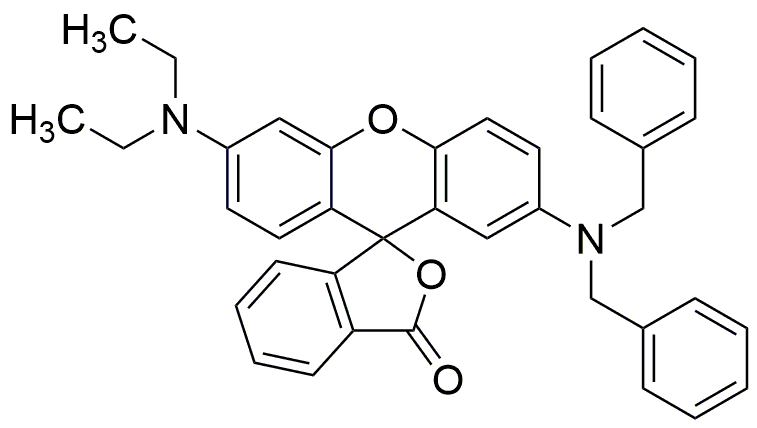2'-(Dibenzylamino)-6'-(diethylamino)fluoran is widely utilized in research focused on:
- Fluorescent Dyes: This compound serves as a highly effective fluorescent dye in biological imaging, allowing researchers to visualize cellular structures and processes with high clarity.
- Photodynamic Therapy: It is used in photodynamic therapy for cancer treatment, where it helps in targeting and destroying cancer cells upon light activation, offering a less invasive treatment option.
- Sensor Development: The compound is employed in the development of sensors for detecting environmental pollutants, providing a reliable method for monitoring air and water quality.
- Organic Electronics: Its properties make it suitable for applications in organic light-emitting diodes (OLEDs), enhancing the efficiency and brightness of displays in consumer electronics.
- Research in Photochemistry: The compound is valuable in photochemical studies, helping scientists explore light-induced reactions and their applications in various fields, including materials science and renewable energy.
General Information
Properties
Safety and Regulations
Applications
2'-(Dibenzylamino)-6'-(diethylamino)fluoran is widely utilized in research focused on:
- Fluorescent Dyes: This compound serves as a highly effective fluorescent dye in biological imaging, allowing researchers to visualize cellular structures and processes with high clarity.
- Photodynamic Therapy: It is used in photodynamic therapy for cancer treatment, where it helps in targeting and destroying cancer cells upon light activation, offering a less invasive treatment option.
- Sensor Development: The compound is employed in the development of sensors for detecting environmental pollutants, providing a reliable method for monitoring air and water quality.
- Organic Electronics: Its properties make it suitable for applications in organic light-emitting diodes (OLEDs), enhancing the efficiency and brightness of displays in consumer electronics.
- Research in Photochemistry: The compound is valuable in photochemical studies, helping scientists explore light-induced reactions and their applications in various fields, including materials science and renewable energy.
Documents
Safety Data Sheets (SDS)
The SDS provides comprehensive safety information on handling, storage, and disposal of the product.
Product Specification (PS)
The PS provides a comprehensive breakdown of the product’s properties, including chemical composition, physical state, purity, and storage requirements. It also details acceptable quality ranges and the product's intended applications.
Certificates of Analysis (COA)
Search for Certificates of Analysis (COA) by entering the products Lot Number. Lot and Batch Numbers can be found on a product’s label following the words ‘Lot’ or ‘Batch’.
Número de catálogo
Número de lote/lote
Certificates Of Origin (COO)
This COO confirms the country where the product was manufactured, and also details the materials and components used in it and whether it is derived from natural, synthetic, or other specific sources. This certificate may be required for customs, trade, and regulatory compliance.
Número de catálogo
Número de lote/lote
Safety Data Sheets (SDS)
The SDS provides comprehensive safety information on handling, storage, and disposal of the product.
DownloadProduct Specification (PS)
The PS provides a comprehensive breakdown of the product’s properties, including chemical composition, physical state, purity, and storage requirements. It also details acceptable quality ranges and the product's intended applications.
DownloadCertificates of Analysis (COA)
Search for Certificates of Analysis (COA) by entering the products Lot Number. Lot and Batch Numbers can be found on a product’s label following the words ‘Lot’ or ‘Batch’.
Número de catálogo
Número de lote/lote
Certificates Of Origin (COO)
This COO confirms the country where the product was manufactured, and also details the materials and components used in it and whether it is derived from natural, synthetic, or other specific sources. This certificate may be required for customs, trade, and regulatory compliance.


